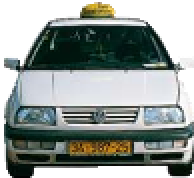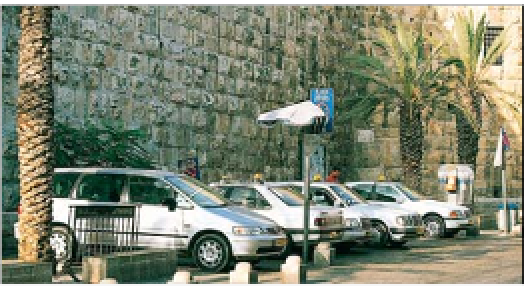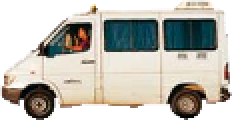Travel Reference
In-Depth Information
Getting Around Jerusalem
Most of Jerusalem's major historical
and religious sites are concentrated
in the Old City, which has to be explored
on foot, as it is almost a completely
vehicle-free zone. Elsewhere, the city bus
network functions efficiently and will get
visitors to more or less everywhere they
might want to go. This is just as well, as taxis tend to
be prohibitively expensive for frequent use. The one
time when visitors might have to resort to taxis is
on Shabbat, when public transport stops running
from sundown on Friday to sundown on Saturday.
Israeli shared taxi, or
sherut
Street sign
Yellow Palestinian taxi
SHARED TAXIS
One slightly unusual means
of transport in Jerusalem
(and throughout the Holy
Land region) is the shared
taxi. Known to the Israelis
as a
sherut
and to th
t
Arabs
as a “service” (pronounced
“servees”), shared taxis are
a cross between a bus and a
taxi. They operate fixed routes
like a bus, but they run far
more frequently and, like a
taxi, they can be hailed on
the street. At the start of the
route drivers wait until every
seat is taken before setting
off. Points of origin and final
destinations are displayed in
the front window (although
in the case of “services”, this
will be in Arabic only). There
are no set stops; passengers
indicate to the driver when
they wish to be let off. Fares
are a little more expensive
than the equivalent bus ride
but much cheaper than a taxi.
Israeli shared taxis are often
white vans, while the Arabs
favour large sedans, usually
Mercedes or Peugeots.
JERUSALEM ON FOOT
an official rank. Restaurant
and hotel staff will always
phone a cab for you.
Taxis are white if they are
Israeli and yellow if they are
Arab. There is little difference
between them. Occasionally
an Israeli driver may refuse to
drive to an address in Arab
East Jerusalem, while an Arab
driver may balk at venturing
into parts of West Jerusalem.
Arab or Israeli, Jerusalem taxi
drivers have a bad, but
very well-deserved,
reputation for over
The old city is very much a
pedestrian zone. Its narrow
streets and alleys do not allow
for vehicles. This makes it a
wonderful area to explore.
Flat-soled footwear is essential,
as many of the ancient streets
are either cobbled or unevenly
paved. There are some areas
of the New City that are also
easy and rewarding to get
around on foot, notably
Yemin Moshe and
Nakhalat Shiva,
but elsewhere
wide roads and
aggressive traffic
can make walking
very unpleasant.
Finding your
way around poses
little problem as street
signs are in at least two
languages (either Hebrew and
English, or Arabic and
English). In the Old City, they
are in the scripts of all three.
r
charging. Although
the taxis have
modern meters
(which can print
out a receipt on
request), drivers
are not in the habit
of using them. They
will often claim that the meter
is not working. You should
insist that it is used. If it is
not, you will pay a variable
fare, which will be dependent
on your haggling skills, but
which will almost certainly be
substantially more than the
meter would have indicated.
Note also that taxi fares are
officially higher between
9:30pm and 5:30am.
White Israeli taxi
TAXIS
BUSES
It is easy to find a taxi in
Jerusalem. You can either
book one by phone, hail one
on the street, or find one at
Jerusalem's city bus system is
run by Egged, the national
carrier, which claims to be the
world's largest bus company
after Greyhound in the United
States. Tickets are bought
from the driver on boarding.
The fare is the same for all
destinations - the equivalent
of just over one US dollar.
Buses are identified only by
a number displayed in the
front window, and destinations
are not usually written. Major
bus routes include: bus No. 1
from
Egged Central Bus
Station
to Jaffa Gate and on
to Mount Zion and the Western
Wall bus station in the Old
Taxi rank on Omar ibn al-Khattab Square inside Jaffa Gate, the Old City











